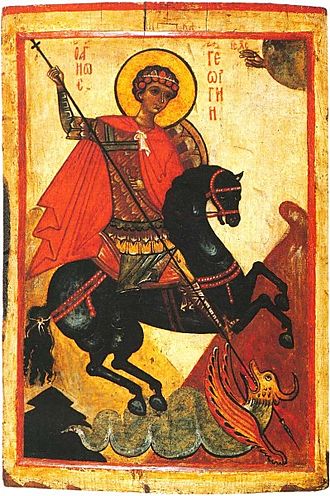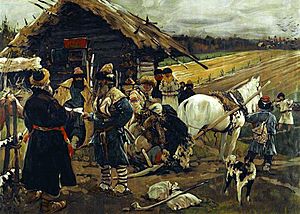George's Day in Autumn facts for kids
Quick facts for kids Saint George's Day
Saint George's Day in Autumn |
|
|---|---|

Icon of Saint George
|
|
| Date | 16 November |
| Next time | 16 November 2026 |
| Frequency | annual |
| Related to | Saint George's Day, and George's Day in Spring |
George's Day in Autumn, also known as Saint George's Day, is a special holiday. It is one of two days in the year that honor Saint George. This day is celebrated by several Christian churches. These include the Russian Orthodox Church, the Serbian Orthodox Church, and the Georgian Orthodox Church.
The other day honoring Saint George is called Saint George's Day of Spring. It is celebrated in May. George's Day in Autumn usually falls in November or December, depending on the calendar used.
Contents
What is George's Day in Autumn?
George's Day in Autumn is a religious holiday. It is celebrated on different dates by different churches. For example, the Serbian Orthodox Church celebrates it on November 16th. The Russian Orthodox Church celebrates it on December 9th. The Georgian Orthodox Church celebrates it on November 23rd. These dates are based on the Gregorian calendar, which is the calendar most people use today.
A Day for Russian Peasants
For many centuries, George's Day in Autumn was very important for Russian peasants. This was during a time when a system called Russian serfdom was common. Serfdom meant that peasants were tied to the land they worked. They were not free to leave without their landlord's permission.
In 1497, a law called the Sudebnik was created. This law allowed peasants to move from one landowner to another. They could only do this during a two-week period around Autumn Yuri's Day. This period included one week before the holiday and one week after it. It was the only time they had this freedom.
However, about a hundred years later, things changed. In 1597, Boris Godunov was a powerful ruler in Russia. He made a new rule that stopped peasants from moving on Yuri's Day. This decision made serfdom much stricter. It meant peasants could no longer leave their landlords. This change made it very difficult for them to improve their lives.
Old Sayings and Traditions
The change in the law about Yuri's Day was a big deal. It led to a popular Russian saying that is still used today. The saying is "вот тебе, бабушка, и Юрьев день". This roughly means "so much for Yuri's Day, Granny." People use it when a promise is broken. It also refers to any failed hope or expectation.
Another Russian word, "объегорить" (ob'yegorit'), also comes from this time. It means "to deceive" or "to fool someone." The word "Yegor" is another form of the name "George." So, it literally means "to Yegor around." This shows how important Yuri's Day was in Russian history and culture.
Serbian Celebrations
In Serbia, George's Day in Autumn is known as Đurđic. It is one of the main days for a tradition called Slava. Slava is a special Serbian Orthodox tradition. Each family has a patron saint, and they celebrate their saint's day. Đurđic is a very important Slava day for many Serbian families.


